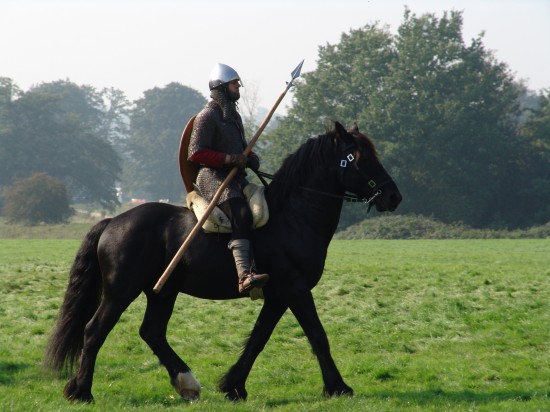
The girth is obviously an important part of a horse's saddlery, which we owe a lot to. Without it, we would presumably have to ride everywhere bareback, and the majority of us would need to develop an almost superhuman degree of balance to cope with that. But consider the implications of the girth on the horse: this small but significant item of saddlery can cause all sorts of discomfort if not properly fitted. There are many different types of girth available, but there are a great deal of considerations to be made before launching into an impulsive purchase.
Firstly, the size of your girth will be your primary concern. The best way to find your horse's girth size is to use either his current girth, or borrow a girth which fits well, and measure that. Of course, if his current girth is too big or small, you may add or subtract an inch or two depending. You could also measure the distance around your horse from the middle of both girth straps, but this may not be as accurate as you might hope. Girth extenders are a possibility if you are already lumbered with a too-short girth, but they can look untidy so it is best to invest in something which does fit.
As with any piece of saddlery, the quality of the material you choose for your girth will affect the welfare and comfort of your horse. Leather will make for a good quality durable product, however it has been known to rub in the elbow crevices of some horses. If this happens, it may be due to the stiffness of the leather, which is a common problem with new girths. Whilst your horse is wearing it in, it will mould to him better, but try to soften the leather up with a specialist leather cream. Ask your saddlery retailer for their recommended brand, as a good quality leather cream will not only keep the girth in good condition, but should prevent it from rubbing your horse. Obviously, if your horse continues to rub, then it may not be appropriate to persist. Consider a neoprene covered girth; these are specifically designed with comfort in mind. They can cause heating under the girth area, but do reduce pressure points which can occur with a cheap webbing girth. Webbing girths are great for your pocket, they are very reasonably priced, but do ensure that your horse is comfortable. Also remember to check for any signs of wear, as these girths can be less durable over time than other materials, and a snapped girth could result in an injury.
The style of girth you choose for your horse, like many saddlery accessories, will often depend on your discipline. For example, if you showjump or event, a stud guard will be essential, as will an overgirth for the latter. For the serious dressage rider, a specialist dressage girth would be ideal, to free up the movement of the elbow and maximise performance. Despite the confusing array of styles available, the main principle to remember is: the larger the surface area of the girth, the more the pressure will be spread out, increasing the horse's comfort. A girth which is contoured around the elbow, whilst widening between the forelegs would be ideal for everyday purposes.
Overall, you must have a very clear idea of what works for your horse, and tailor the girthing process to meet his needs. Don't forget about saddlery accessories such as girth sleeves and elasticated girth straps to adjust the fit and comfort that a girth can provide. Finally, ensure you girth your horse up steadily and gently to avoid any issues developing around the girthing procedure. Once you're pleased with your tack, you and your horse will be ready to enjoy a good ride- whatever it is that you do together!
The Equine Store is packed full of great products for horse and rider, including horse riding saddles in standard sizes or made to measure. Please visit the shop at www.equine-store.com and use customer code 'newcus01' to receive 10% off your first order.
 The Five Greatest Similarities Between Dogs And Cats
The Five Greatest
The Five Greatest Similarities Between Dogs And Cats
The Five Greatest
 Carried Into Battle - The History Of Horses And War
Carried Into Batt
Carried Into Battle - The History Of Horses And War
Carried Into Batt
 Dogs That Don’t Bark As Much As Others
Dogs That Don’t B
Dogs That Don’t Bark As Much As Others
Dogs That Don’t B
 Doggy Day Care - Options For Your Dog If You Work All Day
Doggy Day Care -
Doggy Day Care - Options For Your Dog If You Work All Day
Doggy Day Care -
 Information About Poultry For Potential Poultry Owners
Information About
Information About Poultry For Potential Poultry Owners
Information About
Copyright © 2005-2016 Pet Information All Rights Reserved
Contact us: www162date@outlook.com